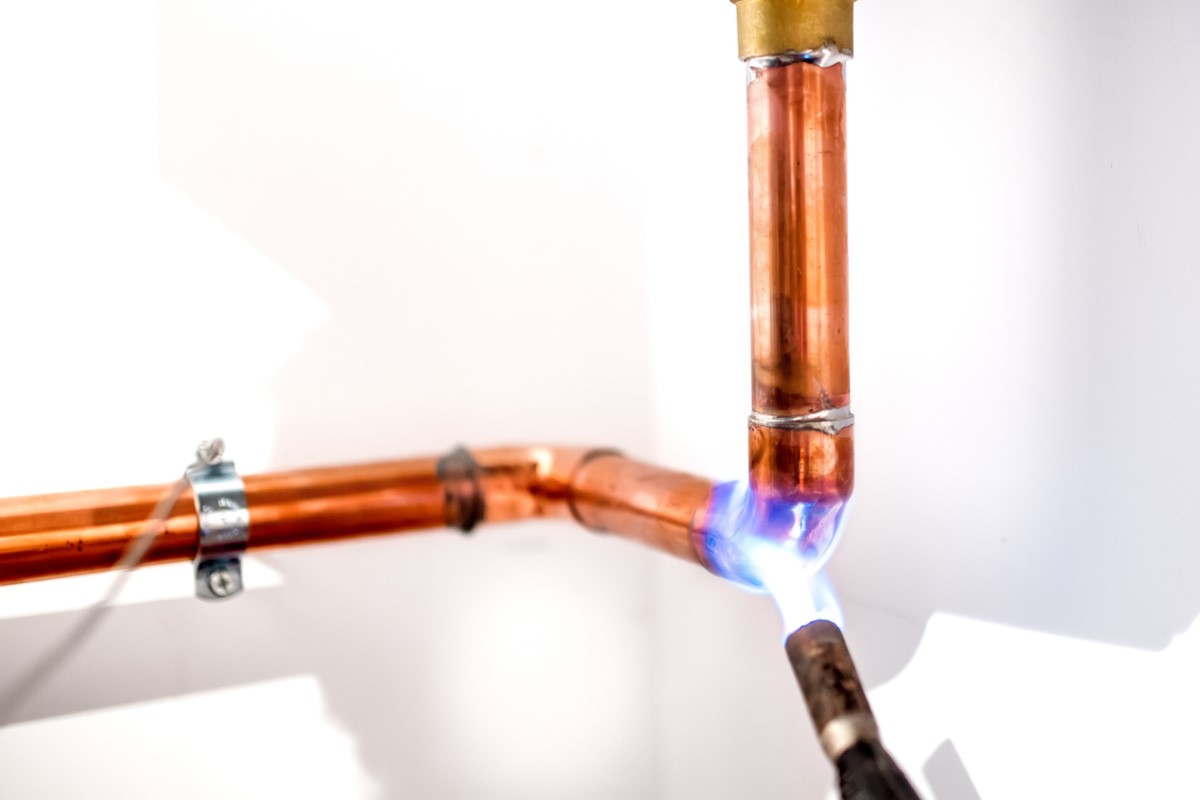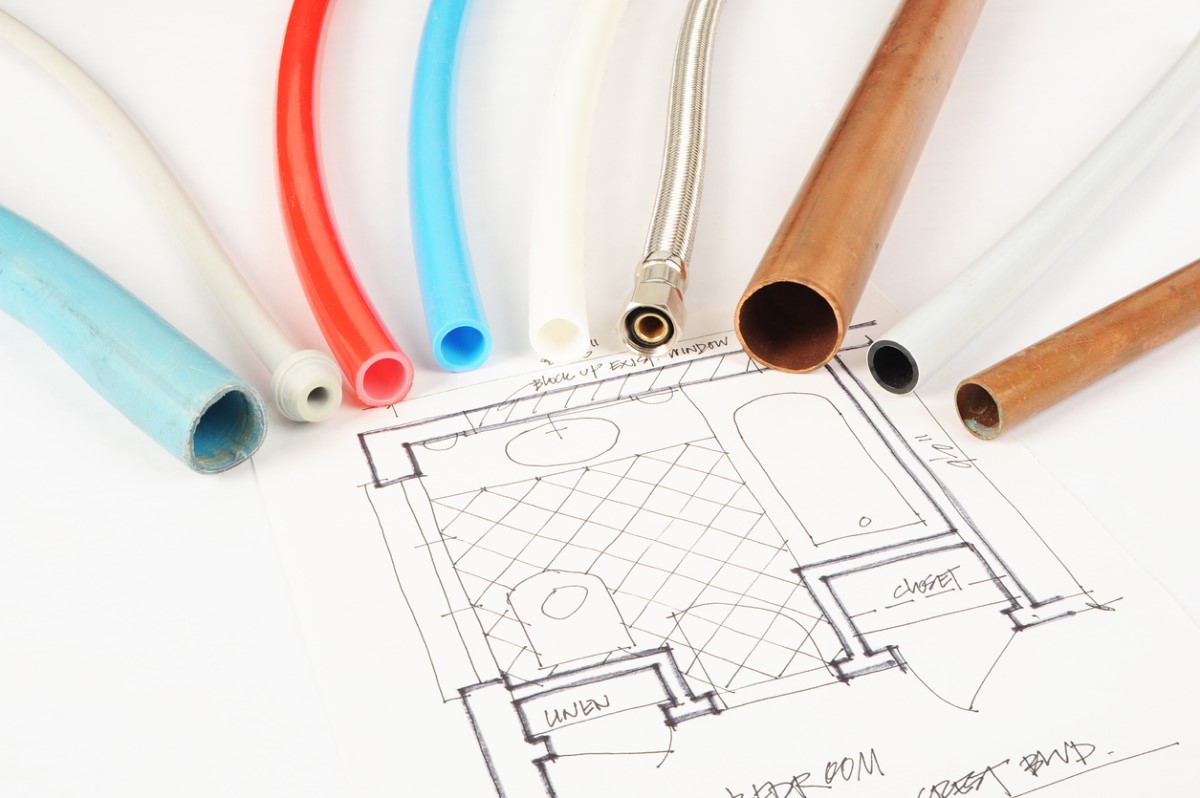We may earn revenue from the products available on this page and participate in affiliate programs. Learn More ›
Once the top choice for all water supply pipes, copper has been nudged a bit to the side by flexible pipes made from cross-linked polyethylene, “PEX” for short. While copper still plays an important role in water pipes for new construction, PEX pipe is quickly becoming the choice for remodeling and retrofitting. Both copper and PEX come with a few advantages and disadvantages, so if you’re looking to replace your home’s current water supply system, keep reading. This cheat sheet on PEX vs. copper outlines the main differences between the two materials so that you can make an educated decision for your plumbing project.
RELATED: 10 Plumbing Tips Everyone Needs to Know
Copper lasts longer than PVC pipes.
It’s tough to beat copper pipes for longevity, which on average last 50 to 70 years, compared to PEX, which has an expected lifespan of 30 to 50 years. PEX’s life expectancy can be shortened by the use of extremely hot household water (180 degrees Fahrenheit or higher) or if the water in the home contains high levels of chlorine.
Copper’s life can be shortened by highly acidic water. When installed under typical conditions (i.e., your home is connected to a municipal water system), copper can be expected to outlast PEX by about 20 years. If you’re on a private well, have your water tested prior to retrofitting your water supply system. Local County Extension Offices can test well water to determine whether it’s high in acid or chlorine.
Copper is also costlier.
In recent years, the cost of copper has risen substantially due to its increased recycle value, so products made from copper have increased as well. On average, installing copper water pipes will be 58 percent to 68 percent more expensive than PEX. For example, you could expect to pay $8,000 to $10,000 to have a plumber replace the old pipes with new copper pipes in an average, two-bath, 1,500-square-foot home versus $4,000 to $6,000 for PEX.

PEX requires fewer connections.
Since copper is rigid, it must be cut to size and have elbow fittings installed every time it comes to a corner, such as where it turns from a vertical run between studs to a horizontal run to meet a sink. More connections mean more installation labor. PEX, on the other hand, runs continuously all the way from a water-distribution panel (called a manifold) to each fixture (tub, sink, etc.). PEX bends easily around corners so no additional connections are necessary.
In a remodeling project, flexibility is a big plus, because the PEX pipe can be snaked through finished walls without the need to cut out drywall. To have new copper pipes installed in a finished home, the drywall must be removed to give the plumber access to make connections.

PEX offers a central shutoff.
Most water fixtures, such as tubs, sinks, and showers, have individual shut-off valves located somewhere nearby. In the case of a sink, it’s usually in the vanity cabinet below, but shut-off valves for tubs and showers are often located behind access panels held in place with screws, making it a chore to access them.
With PEX, every pipe connects to the water-distribution manifold (usually located near where the water main enters the house), and each individual pipe has its own shutoff valve directly on the manifold. The manifold features labels for each shutoff valve, such as “Bathtub” or “Laundry Room Sink,” so turning the water supply off and on for any fixture is simple.
Copper is more likely to freeze and break.
One of the biggest disadvantages of copper pipes is their tendency to crack if the water inside freezes and expands. Having a degree of flexibility, PEX is able to expand if the water inside it freezes, making PEX more resistant to freeze-breakage.
That said, in new house construction, there’s little risk from copper pipes freezing and breaking, because today’s plumbing practices are designed to keep the pipes insulated and safe.
The problem is more common in older homes that lack adequate insulation. If you live in a cold region and your home is under-insulated—or if you’ve had trouble with water pipes freezing in the past—it might be a good idea to go with PEX when having the pipes replaced.
RELATED: How to Keep Pipes From Freezing and Bursting
PEX is more DIY-friendly.
For DIYers, PEX is the easier type of pipe to install. Making the connections necessary in copper pipes requires the use of a torch to solder and seal the fittings.
PEX pipes connect with a number of easy-to-use fittings, including quick-connect fittings that connect just by pushing them together, crimp fittings (requiring a special crimp tool), or clamp fittings (calling for a clamp tool).
Manufacturers of each type of fitting usually feature detailed installation videos on their websites, and since PEX is flexible, you’ll only need to make two connections for each fixture—one at the manifold, and the other at the fixture itself.
Note: Permission to install new plumbing in your own home depends on the building codes in your community, so contact your local building authority before you start.


